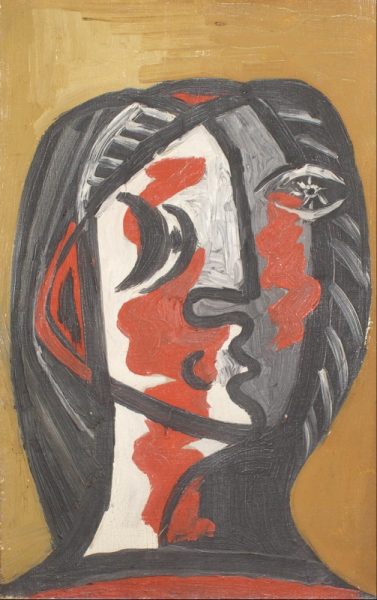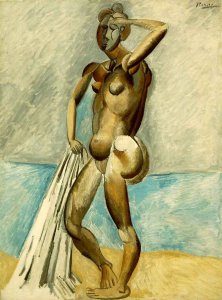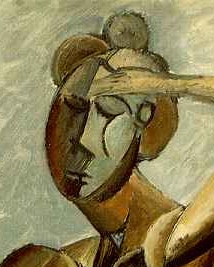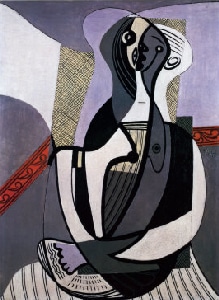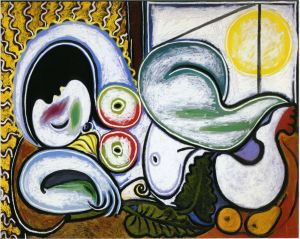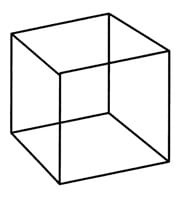Head of a Woman in Gray and Red
Date: December, 1926
Medium: Oil on canvas
Dimensions: 22.2 x 14 cm. (8 ¾ x 5 ½ inches)
Inscription: Inscribed “Décembre 26” on the stretcher in Picasso’s distinctive handwriting
References:
• The Picasso Project (Wofsy), Picasso’s Paintings, Watercolors, Drawings and Sculpture: A Comprehensive Illustrated Catalogue 1885-1973, Toward Surrealism 1925-1929, San Francisco, 1996, no. 26-097, ills. p. 76.
• Josep Palau i Fabre, Picasso 1917-1926: From the Ballets to Drama, English edition published by Konemann, Cologne, 1999, full-length, three-quarter page color illustration on page 482.
• David Douglas Duncan, Picasso’s Picassos, Ballantine Books, New York, 1968, ills. p.211.
• Mallen, Enrique, ed. Online Picasso Project. Sam Houston State
University. 1997-2017. OPP.26:003, ills.
Provenance:
• Estate of the artist (Succession no. 12423), thence to a private collection.
• Maya Widmaier-Picasso and Claude Picasso have both confirmed the authenticity of this painting, and their certificates of authenticity accompany its sale.
Price: Sold
Picasso’s output in 1926 seems thin in quantity, if not in quality. At least not much of his work of that year has survived. According to John Richardson, much of his work that year was stolen and never seen again, presumably having ended up in a ditch somewhere. I imagine aesthetic sensibilities were not the thief’s strong point–certainly Picasso’s surrealism would have been less accessible to the average criminal. But even Paul Rosenberg, Picasso’s uncomprehending art dealer at the time, failed to understand it and pestered Picasso to stick to painting “pretty” pictures. (A Life of Picasso: The Triumphant Years, 1917-1932). As a result, his surrealist paintings were not even shown for a number of years.
Today we understand 1926 as a seminal year in Picasso’s art, of which this portrait is a paragon. This is a portrait of a woman, or perhaps one should say two women, as there are distinctly two profiles within it, each facing and inextricably interdigitating with the other. The design of this portrait is akin to contour drawing, in which a line defines the contour, or edge, of the figure, and which has the effect of flattening the object onto the canvas with a complete loss of perspective along the way. In this case the line is very bold and thick, heightening the definition and planar aspect of the composition. The painterly quality of this small jewel is enhanced by Picasso’s use of impasto, the technique of applying paint so thickly that brush strokes are readily visible.
It is interesting to note the common threads that run through Picasso’s various styles through the many decades of his ouevre. In this regard, our painting represents one of Picasso’s very earliest portrayals of two faces in one. He had hinted at this stylistic device once in 1924 and several times in 1925. There was at least one much earlier, partial foray into this uncharted territory as far back as 1908, in the important painting Baigneuse, which is also the same portrait in which, it seems to me, that he first “pared” the human torso in order to depict at once the buttocks and the genitalia (Z. Vol. II, no. 111, The Museum of Modern Art, NY, illustrated below). This painting may not have depicted two entirely separate faces on the same shoulders, but a stylistically related artifice of simultaneously portraying a frontal view and profile.
But in 1926, he began exploring this two-faced style in earnest and produced ten small oils, of which this is one, almost all in a similar palette. The vast majority are, frankly, hard to look at, even for an inveterate Picasso lover such as myself. Picasso, on the other hand, must have loved these creations, as he kept five of them including this one in his personal collection (as we know since they are illustrated in Duncan’s Picasso’s Picassos.) This one is the nicest of the lot, with provocative facial expressions on both sides but none of the gruesome facial features that distinguished some of the others. (Upon reading this claim, a curator and friend of mine, after dutifully marveling at this beautiful painting, offered the following saying from a prominent German art collector. Never sit at table with horse traders—or art dealers. When selling the art dealer will always say, “It is the best artist, the best year, the best colors.” When you go to sell, it is always the wrong artist, the wrong period and the worst palette.) So if you don’t believe me, or simply wish to see for yourself, here’s an example of one of the lackluster portraits that month of similar size, Femme Assise (last sold at Christie’s NY, Impressionist & Modern Art Evening Sale, May 9, 2007, lot 57):
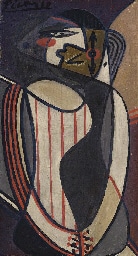
The fact that the MOMA deaccessioned the above painting, which it had received as a bequest, supports my opinion of it. Yet it fetched a tidy sum back then. Apart from this seated woman, the remaining nine oils in this series are “headshots”.
The closest comparable painting in the auction record is in the special Krugier Evening Sale at Christie’s NY in November, 2013, which sold for almost double the above:
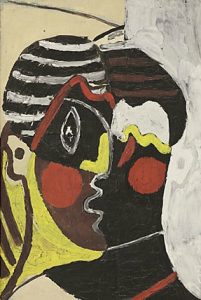
It is in the same series of 10 small oils of almost identical size from 1926. Although the entire series is important as a stylistic precursor to the Marie-Therese paintings and sculptures of the early ’30s, Tête de femme en gris et rouge is clearly the strongest and most beautiful of the lot. In addition, there is extensive craquelure in the Christie’s Krugier piece (better seen in a high-resolution photo, which I could provide), whereas the condition of ours is flawless. Picasso began this series late in 1926 (exactly when is unknown), and he concluded it in December of that year with three portraits. Tête de femme en gris et rouge is one of those last three, possibly the very last. It would make sense if it were the last one, since it is the culmination of the series, not only in terms of its relative beauty. The incoherent design of the Krugier painting is typical of the series (with the sole exception of Tête de femme en gris et rouge)–clearly Picasso was struggling to get his “breakthrough” right. If the remainder of the series represented his return to the “problem” of depicting two faces in one, not until the painting at hand did he fully solve the problem.
To my knowledge, Tête de femme en gris et rouge is the only painting of the series that was chosen to be reproduced in a lithograph (or so-called lithograph) that is available on the market today, from which I gather that at least one other person seems to have shared my opinion that it is the best of the series. If you care to delve further into the comparative analysis of this series, may I suggest that you purchase the third volume of Palau i Fabre, wherein you will find photos of most of the series, mostly in color. I am confident that this exercise would confirm for you that Tête de femme en gris et rouge is indeed by far the best of this seminal lot. The other references also contain photos, but they are smaller and not in color.
Tête de femme en gris et rouge also compares favorably, despite its far smaller size, to the painting Femme Assise of the following year that the SFMOMA chose to use for its poster advertising the2007 “Picasso and American Art” exhibit, which it hung all over San Francisco (and presumably all over NYC, as the show originated at the Whitney), shown below:
Picasso’s “surrealism” is finally coming into its own, with a large exhibit at the Fondation Beyeler, Basel 2005 (a nice catalog is available authored by Ann Baldassari, director of the Musée Picasso, Paris), a conference in March, 2007, at UC Berkeley (I walked over) coupled with upwards of a milion-dollar Mellon grant to the UC professor, T. J. Clark, who is studying that Picasso period and who organized the symposium. Like late Picasso, Picasso’s surrealism has taken a while to establish proper public adoration, and its upward trend is still in progress. I expect much more relative appreciation in the near future, not the least of which additional reasons is that John Richardson’s third volume of his magnum opus biography, A Life of Picasso: The Triumphant Years, 1917-1932, has recently been published to wide acclaim. It features Picasso’s surrealism, as well as the last years of his neoclassicism and synthetic cubism.
The straight nose-to-forehead line which Picasso first used in the small series of paintings to which this work belongs, in this case in the face on the viewer’s left, was a direct link in the evolution of his portraits of Marie-Thérèse, such as the great plaster and bronze sculptures and “sculptural” prints of Marie-Thérèse of 1930-1933, such as the print on our website, Tête de Femme (Bloch 256, https://ledorfineart.com/B256_Tete_de_Femme.html) , or the celebrated paintings of her from the early ‘thirties, such as Nu Couché (1932, Musée Picasso):
Picasso is generally believed to have met Marie-Thérèse in 1927, but there are those who contend that they actually met in 1925. Picasso’s early portraits of his secret muse were veiled, so if indeed this is a portrait of her, it would not be surprising that he might have omitted the shock of yellow hair that characterized her more revealing later portraiture. Or, as also happened at other times, Picasso may have begun painting an archetypal woman, only to have its exemplar enter his life in short order, as if he had created his muse.
Our head of a woman also represents one of Picasso’s early explorations of surrealism, the cutting-edge movement in art of the period. He had already completed his first two surrealist masterpieces the year before, with which he had yet again shocked the art world, La Danse (June 1925, London, Tate Gallery) and Le Baiser (Juan-les-Pins, summer 1925, Paris, Musée Picasso). Though Picasso refused to ally himself with this movement, he was clearly its inspiration and its vanguard. As André Breton, who is best known as the principal founder of surrealism, conceded, “Surrealism, if it tends to define a line of action, simply has to go where Picasso has gone, and where he will return” (quoted in C. Piot et al, The Ultimate Picasso, New York, 2000, p. 232). Along these lines, the following summation by the art historian Rosalind E. Krauss helps to place this painting within its historical context, “Many of the historians of Picasso’s work…speak of this moment as the onset of an important connection between the artist and surrealism, agreeing more or less with André Breton’s statement that it was in this year—1926—that Picasso ‘joined’ the movement, at least in spirit (“Life with Picasso: Sketchbook No. 92, 1926”, in Je Suis le Cahier, The Sketchbooks of Picasso, edited by Arnold and Marc Glimcher, The Atlantic Monthly Press, Boston/New York, 1986).
But Picasso was likely much more influenced by his own creative originality and by the circumstances of his personal life than by the fashion of the times in the art world. It is probably not at all coincidental that he moved beyond the lovely, refined neoclassical style, which he had elaborated during the salad days of his first marriage, to the raw, unsettling surrealism with which he progressively replaced it as his first marriage unraveled. Yet here Picasso provides an idealized portrait of woman, depicted with the crescent moons of one eye and the star of the other, as if to to underscore the importance of Woman. Woman is his sun and his moon. All is Woman.
Sir Roland Penrose, one of Picasso’s principal biographers, described the radicalism of Picasso’s surrealism in the context of his previous work as follows, “These excursions into realms formerly forbidden by a canonical respect for beauty were more profoundly disturbing than the attacks made by Cubism on academic conceptions of painting. They upset man’s vision of himself which had sprung from classical tradition. But we were to discover, thanks to Picasso, that the image of man did not reside only in an ideal conception, but that in its nature it should be organic and alive.” (Picasso: Life and Work, Berkeley, 1981, pp. 255-256)
Roland Penrose includes among the illustrations in his biography of Picasso another example from this series of small surrealist portraits dating from the autumn of 1926. About them, he writes, “The liberties that Picasso now chose to take with the human form seem unbounded. Even the most daring rearrangements of features and revision of proportions did not however prevent the recognition of the human head and human form. The cubist method of describing an object simultaneously from more than one viewpoint had induced Picasso, as early as 1913, to inscribe a profile on a head seen full face. But in 1926 the same idea was carried further in paintings of violently distorted heads in which the recognizable features—eyes, mouth, tongue, ears, nose and nostrils—are distributed about the face in every position, with the bold line of a profile making a central division of the head…. Every imaginable permutation is tried but miraculously the human head survives as a unit powerfully expressive of emotion.” (Picasso: His Life and Work, University of California Press, Berkeley and Los Angeles, 1981 [original copyright 1958], p. 253)
You may have noticed that you cannot view both profiles in this “double” portrait simultaneously. And it’s not just you–this is a universal neurological limitation of perception. It may not seem like much, but the fact is we are physically incapable of seeing both faces at once. It’s a similar mental exercise to viewing the classic cube below–which surface is in front? And now rearrange your perception so that the “back” face comes to the fore:
But just think about it–Picasso had to paint this thing. Could he have been an exception to this universal neurological rule? Unlikely. Or did he flip the developing images back and forth in his mind as he advanced his line down the canvas? The ability to do that alone would still be an impressive feat. However, perhaps one shouldn’t underestimate his genius. Think only of his party trick: how as a young man he used to amuse his friends who sat opposite him at cafés by drawing their portraits upside down to him, but facing them.
The double-faced portrait became one of Picasso’s signature styles, and he made thousands of variations of it for the rest of his life, spanning almost another half-century. This painting, then, is highly significant as one of the very earliest of these many two-faced paintings. It’s rawness, strength and power “holds the wall”, quite disproportionately to its size.
But this painting is also unusual, even within its two-faced genre, to the extent that the double-face pulls the viewer in and forces visual interaction. Notice, if you will, that viewing this painting is an unavoidably dynamic process. Your mind’s eye can’t stay still—as long as you don’t force it to focus on just one of the profiles, it will spontaneously and continually flip back and forth from one profile to the other. This effect might be disconcerting if it were not so amusing and wondrous, and if the painting were not so beautiful. Interestingly, this may be one of the first instances of interactive art, achieved no less in a two-dimensional painting without any levers or buttons to pull or push.
It is worth taking another moment to study the overall formalism of this composition, particularly this portrait’s facial construction. As is usual in so many of Picasso’s greatest works, this formalism is truly a tour de force. Follow the lines with your eye—see how inventively and surprisingly the peripheral curves delimit and unite the facial contours. Far from the spontaneous and haphazard for which the Surrealists strove, this head is carefully contrived, tightly constructed into a geometric masterpiece. This painting should primarily be celebrated as a triumph of Picasso’s ingenious, complex, inimitable, and beautiful formalism, his “surrealistic” style de jour. Its personal meaning for him could have been an expression of his feeling towards Woman: his sun and his moon, the essence of life, the focus of his being. A less charitable interpretation takes into consideration the year, 1926, which was well beyond the honeymoon period of his marriage.
Everything that needs to be said about the shape of the white nose has probably already been covered in the literature. But I’d like to briefly direct your attention to the mouth’s expression in each face. These lips may seem simple, simplified, and inconsequential at first glance, but they have always left me with the feeling that they are somehow also rather expressive. Expressive of exactly what is however in my case the subject of delayed reflection. Having lived with this piece for some time now and really looked at it now upon countless occasions, I can without doubt say the following. In a word—and I don’t know how he did it so simply and yet convincingly, and with such a sparing line at that—each mouth somehow conveys the look of expectance, or even anticipation, especially the white face. As opposed to say, the “penis-head” print in our collection (Tête de Femme, Bloch 256), in which the expression communicated is strictly ethereal and serene. Really, how does he pull it off? It would take a scholar of physiognomy and expression to answer that (these people exist and have conducted fascinating research, by the way, in case you didn’t know…), I suppose, but I suspect that intuitively it’s nonetheless clear to laypeople such as you and me.
***************************************
The following may be a matter of semantics, but it helps to distinguish Picasso from the “other” surrealists. It seems to me that the commonplace connotation, at least among English speakers, of the word “surreal” is what one would expect if the word were “unreal”. We non-native French speakers, or non-French speakers at all, forget that the word means “above reality”. “Sur” means above, not below, and so surrealism is greater, not less, than reality.
“Picasso’s view of surrealism was the antithesis of Breton’s. As he told Kahnweiler in 1933, ‘the surrealists never understood what I intended when I invented this word [this was not entirely true], which Apollinaire later used in print—something more real than reality.’ ‘Resemblance is what I am after,’ Picasso reiterated to Andre Warnod, ‘a resemblance deeper and more real than the real, that is what constitutes the sur-real.’ In 1951, when discussing his great sculpture of a goat (a pregnant goat, whose anus he planned to plug . with a squeaker), the artist claimed, ‘She’s more like a goat than a goat!’
“Leiris, who was closer intellectually to Picasso than anyone else, vaunted the artist’s sur-realism as opposed to surrealism in an article—all too clearly authorized by the artist—inDocuments in February 1929. Now that he had been expelled—along with Bataille, Desnos, and Artaud—from the surrealist movement, Leiris was free to declare that Picasso did not belong with the surrealists. His painting was too ‘down to earth [terre à terre]: [it] never emanates from the foggy world of dreams, nor does it lend itself to symbolic exploitation—in other words, it is in no sense surrealist.’
“As for the surrealist poets…, Picasso claimed that surrealist poetry was the sort that ‘appeals to pale young girls rather than girls in good health on the grounds that moonlight is more poetic than sunlight etc…. Dada followed a better route.’
“Picasso particularly derided the surrealists for their faith in automatic writing as a shortcut to the subconscious. ‘Just look at this automatic poetry,’ he told Otero years later, as he brandished the original manuscript of Breton and Eluard’s L’Immaculee Conception) its pages covered with authors’ corrections. ‘This poetry is as automatic as I am an Egyptian-style painter, as [the Douanier] Rousseau used to say.’ It was not that Picasso thought automatic writing intrinsically silly, though that too, so much as intrinsically factitious—at least in surrealist hands. Picasso felt even more strongly about automatic drawing.’” (J. Richardson, A Life of Picasso: The Triumphant Years, 1917-1932, p. 349)
